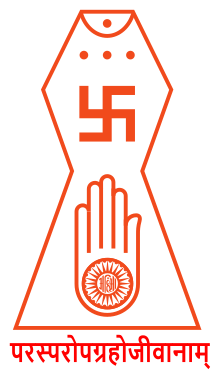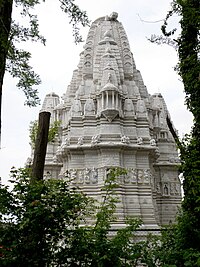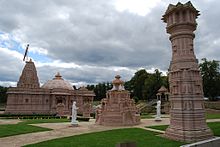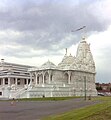
Jainism, also known as Jain Dharma, is an Indian religion. Jainism traces its spiritual ideas and history through the succession of twenty-four tirthankaras, with the first in the current time cycle being Rishabhadeva, who lived millions of years ago, the twenty-third tirthankara Parshvanatha, whom historians date to the 9th century BCE, and the twenty-fourth tirthankara Mahavira, around 600 BCE. Jainism is considered an eternal dharma with the tirthankaras guiding every time cycle of the cosmology. Each individual soul possesses boundless bliss and infinite knowledge which is obscured due to its misidentification with the body. Therefore, central to understanding Jain philosophy is the concept of bhedvigyān, or the clear distinction in the nature of the soul and non-soul entities. This principle underscores the innate purity and potential for liberation within every soul, distinct from the physical and mental elements that bind it to the cycle of birth and rebirth. Recognizing and internalizing this separation is essential for spiritual progress and the attainment of samyak darshan or self realization (atma-anubhuti), which marks the beginning of the aspirant soul's journey towards liberation. The three main pillars of Jainism are ahiṃsā (non-violence), anekāntavāda (non-absolutism), and aparigraha (non-possessiveness).
Virachand Raghavji Gandhi was a Jain scholar who represented Jainism at the first World Parliament of Religions in 1893. A barrister by profession, he worked to defend the rights of Jains, and wrote and lectured extensively on Jainism, other religions, and philosophy.

Valsad district is one of the 33 districts in the Western Indian state of Gujarat. It is bound by Navsari district to the north, Nashik district of Maharashtra state to the east, and Dadra and Nagar Haveli district of the Dadra and Nagar Haveli and Daman and Diu (DNHDD) union territory and the Palghar district of Maharashtra to the south. The Arabian Sea lies west of the district. The coastal Damaon enclave of DNHDD is bounded by Valsad district on the north, east, and south. The district's administrative capital is Valsad. The district's largest city is Vapi.

Jainism has been present in Maharashtra since ancient times. The famous Ellora Caves demonstrate that Jainism was part of a thriving religious culture in Maharashtra in premodern times.

Rajasthan, a state in western India, has had a close historical connection with Jainism. Southwestern Rajasthan was the main centre for Śvetāmbara Jainism. Major Digambara centres are in the northern and eastern parts of Rajasthan. Central and Northern Rajasthan are the main centres for the Terapanth sect of Śvetāmbara Jainism.
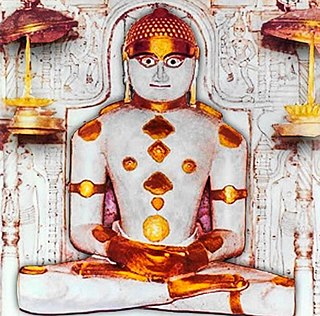
Rishabhanatha, also Rishabhadeva, Rishabha or Ikshvaku, is the first tirthankara of Jainism. He was the first of twenty-four teachers in the present half-cycle of time in Jain cosmology and called a "ford maker" because his teachings helped one cross the sea of interminable rebirths and deaths. The legends depict him as having lived millions of years ago. He was the spiritual successor of Sampratti Bhagwan, the last Tirthankara of the previous time cycle. He is also known as Ādinātha, as well as Adishvara, Yugadideva, Prathamarajeshwara and Nabheya. He is also known as Ikshvaku, establisher of the Ikshvaku dynasty. Along with Mahavira, Parshvanath, Neminath, and Shantinath, Rishabhanatha is one of the five Tirthankaras that attract the most devotional worship among the Jains.
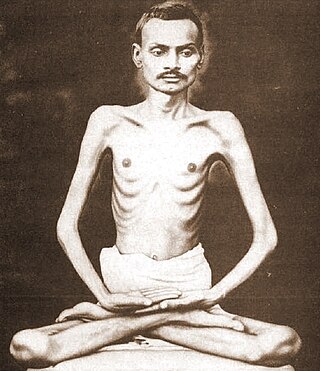
Shrimad Rajchandra, also known as Param Krupalu Dev, was a Jain poet, mystic, philosopher, scholar, and reformer from India. Born in Vavaniya, a village near Morbi, he claimed to have attained recollection of his past lives at the age of seven. He performed Avadhāna, a memory retention and recollection test that gained him popularity, but he later discouraged it in favour of his spiritual pursuits. He wrote much philosophical poetry including Atma Siddhi Shastra. He also wrote many letters and commentaries and translated some religious texts. He is known for his teachings on Jainism and his spiritual guidance to Mahatma Gandhi.
Jainism is an ancient Indian religion belonging to the śramaṇa tradition. It prescribes ahimsa (non-violence) towards all living beings to the greatest possible extent. The three main teachings of Jainism are ahimsa, anekantavada (non-absolutism), aparigraha (non-possessiveness). Followers of Jainism take five main vows: ahimsa, satya, asteya, brahmacharya (chastity), and aparigraha. Monks follow them completely whereas śrāvakas (householders) observe them partially. Self-discipline and asceticism are thus major focuses of Jainism.
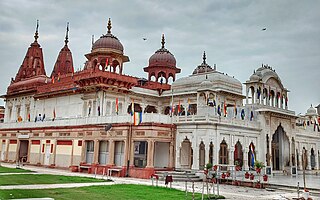
Shri Mahavir Ji is an important and prominent Jain pilgrimage site situated in Shri Mahaveerji town in Hindaun Block, Karauli district in Rajasthan. Given the importance of the religious place, the Indian Railways has specifically developed a railway station under West Central Railway zone by the name of Shri Mahaveerji railway station which is 10 minutes drive from the temple and temple authorities have arranged for regular buses from the station to the temple. The temple is visited by millions of Jain and Hindu devotees every year.

Rakesh Jhaveri, also known as Pujya Gurudevshri Rakeshji, is a spiritual leader, mystic, scholar of Jainism, author and orator from India. Spiritually inclined from a young age, he is a follower of Shrimad Rajchandra, a Jain spiritual teacher. He completed doctoral studies on Shrimad's work Atmasiddhi. He founded Shrimad Rajchandra Mission, Dharampur which supports spiritual and social activities.
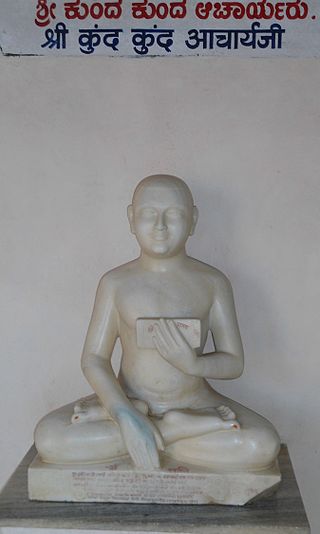
Digambara is one of the two major schools of Jainism, the other being Śvetāmbara (white-clad). The Sanskrit word Digambara means "sky-clad", referring to their traditional monastic practice of neither possessing nor wearing any clothes.

The Jains in Belgium are estimated to be around about 1,500 people.
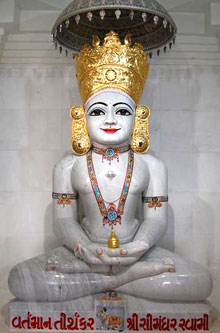
Simandhar or Simandhara is a Tīrthaṅkara, an arihant, who is said to be currently living in another world in the Jain cosmological universe.
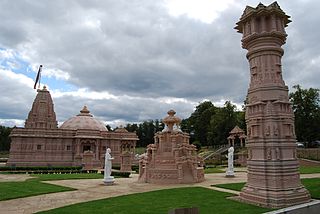
Adherents of Jainism first arrived in the United Kingdom in the 19th century. Britain, mainly England, has since become a center of the Jain diaspora with a population of 40,000 in 2007. The 2021 United Kingdom census recorded a population of 24,991 Jains in England and Wales, and 44 Jains in Northern Ireland.
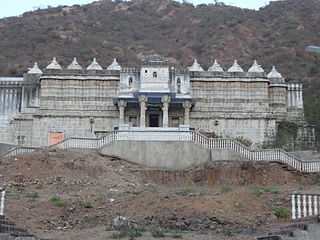
Mirpur Jain Temple is a site of Śvetāmbara Jain pilgrimage situated in Mirpur, a fortified village in the Sirohi district of Rajasthan, India. The village has four Jain temples.

In Jainism, Bharata was the first chakravartin of the Avasarpini. He was the eldest son of Rishabhanatha, the first tirthankara. The ancient name of India was named Bhāratavarsha or Bhārat or Bharata-bhumi after him. He had two sons from his chief-empress Subhadra, named Arkakirti and Marichi. He is said to have conquered all six parts of the world and to have engaged in a fight with Bahubali, his brother, to conquer the last remaining city of the world.

Champat Rai Jain was a Digambara Jain born in Delhi and who studied and practised law in England. He became an influential Jainism scholar and comparative religion writer between 1910s and 1930s who translated and interpreted Digambara texts. In early 1920s, he became religiously active in India and published essays and articles defending Jainism against misrepresentations by colonial era Christian missionaries, contrasting Jainism and Christianity. He founded Akhil Bharatvarsiya Digambara Jain Parisad in 1923 with the aim of activist reforms and uniting the south Indian and north Indian Digambara community. He visited various European countries to give lectures on Jainism. He was conferred with the title Vidya-Varidhi by Bharata Dharma Mahamandal.
Events in the year 1867 in India.

Siddhantacharya Pandit Phoolchandra Shastri was a Jain scholar, writer, editor, freedom fighter, social reformer and an intellectual giant in the field of Jainism. He is best known for dedicating a major part of his life in translating to Hindi the foremost and the oldest Digambara Jain Canon, Shatkhandāgama and Kasayapahuda, and its commentaries, Dhavala, Maha-Dhavala and Jai-Dhavala. He was also an active member of the Indian National Congress during the Indian struggle for freedom. Panditji was a strong advocate and proponent of abolishing many evils within the Jain community and was the founding member of many institutes of learning and scholarship. As a recognition of his contribution to Jain philosophy, he was conferred a title of "Siddhantacharya" at Jain Siddhant Bhavan, Ara (Bihar) in 1962 by the Governor of Bihar Ananthasayanam Ayyangar.
